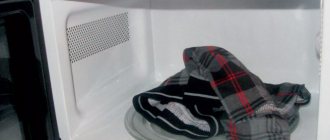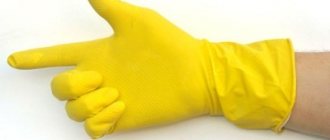We were flooded and black mold appeared under the linoleum, what should we do? This question was sent to us in feedback, and the answer filled an entire article.
We will analyze the questions of how to dry the floor under linoleum and laminate after flooding; Is it possible to remove traces of fungus on a concrete floor without major repairs? We will also consider the situation with wooden floor boards, whether they can be treated without replacement.
Small spoiler:
- If the laminate is swollen, throw it away; it will not return to its shape.
- If you have linoleum with a jute or foam base, you will also have to throw it away, alas.
Try our methods and share yours in the comments.
How to dry the floor under linoleum after flooding
Procedure:
- Remove the covering - linoleum or laminate.
- Remove the backing, if present.
- Ensure positive room temperature.
- Install powerful fans to circulate air.
- Install mobile dehumidifiers if possible.
These are independent measures, you can try similar services in the video that will dry any floor under laminate, parquet and linoleum.
If you were flooded by your upstairs neighbors and because of them mold appeared, you can read the story of How Alena was flooded by her neighbors and she compensated for the damage through the court in Tinkoff magazine.
There are many materials on YouTube with independent methods, then we will analyze the problem of fungus.
Causes of mold
Mold can spread to walls
Why does mold appear? - The fungus appears due to moisture - the first step is to eliminate the source. All possible causes are divided into groups:
- Incorrect installation of material (subfloor, finishing coating). If installation rules are not followed, moisture accumulates under the linoleum. This can happen if the concrete base is not sufficiently dried and linoleum is laid on it. When the material is laid on a wooden base made of damp boards affected by fungus.
- Moisture, cold “below”. This situation arises if the room is on the ground floor and there is a basement. Then reliable waterproofing is laid under the coating - polyethylene, polyethylene foam.
- Moisture is at the top. This is a difficult case, since moisture accumulates due to a faulty heating system, sewer system, or high humidity in the room. For example: 4 drops from a dripping faucet in 24 hours, falling on the coating joint, leads to the formation of mold under the linoleum. In this situation, the edges of the linoleum are glued and the baseboards are pressed tighter. It is better to use plastic products - they have a rubberized edge and do not rot.
- Freezing of the foundation and walls of the building leads to a decrease in temperature and the appearance of condensation on the lower base of the linoleum. Is there a way to remove mold?
Attention! Materials with a felt, cellulose, or cotton base are susceptible to mold and mildew.
How to get rid of mold on linoleum using folk remedies
Every person has to deal with mold. And in addition to black mold, white rot may also appear in the house, which can quickly ruin a wooden floor .
At the same time, it will also smell very strongly. People began to fight fungi a long time ago; a lot of methods have accumulated; we have identified the most effective ones. You can cope on your own using only improvised means if the lesion is insignificant. When there are huge stains, it will be difficult to completely destroy these microorganisms, and the resulting mold smell is also unlikely to be removed.
Copper sulfate
Copper sulfate gives a good effect. Dissolve it in a ratio of 0.1 kg of powder per bucket of water. For heavily grown fungus, it is sometimes recommended to increase the dose of powder by 2-4 times. Some also add vinegar (0.2 l) or a chlorine-containing preparation.
When working with this product, you should take precautions - protective gloves, goggles, a respirator and thick clothing.
Lemon acid
Fungal spores react negatively to acids. Therefore, citric acid will come in handy here. If the mold outbreak is not large, it is enough to dilute 5 tbsp. in 1 liter of water and treat the affected surface with the solution.
Chlorine and similar products
Preparations containing chlorine compounds help to effectively get rid of not only the mold itself, but also destroy its spores along with the smell of rot. You will need 1 liter of product per bucket of water (regular Whiteness bleach will also work).
Work should be done using personal protective equipment in a well-ventilated area.
Borax
Many properties are attributed to this product - fungicide, herbicide, insecticide. For mold, borax is a strong poison that inhibits its development . It is necessary to dilute 4 cups of the product in a bucket of water and treat the surface several times.
Ultimately, borax will not only destroy the entire fungal colony, but also create a protective film on the floor . Therefore, it is not recommended to wash off the solution from the surface .
What are the health implications of dampness in your home?
Dampness also negatively affects human health. Children and the elderly are especially affected by mold and mildew.
Among the most common consequences of living in a damp room are the following:
- allergic reactions;
- development of dermatoses and mycoses;
- the occurrence of asthma attacks;
- ARVI;
- headache;
- constant malaise;
- dizziness;
- nausea;
- insomnia.
If the house smells damp, existing chronic diseases can suddenly worsen. Also, most common seasonal pathologies can, on the contrary, become chronic. Therefore, living in a humid microclimate entails not only negative aesthetic, but also physical problems.
Professional products
The chemical industry has also produced a large number of different preparations to eliminate the smell of rot and remove fungus. But they are often very expensive due to complex components and marketing hype.
- "Boramon" is great for treating any surface.
- “Mellerud” almost instantly kills the fungus and its spores, while the drug easily penetrates the porous structure of the surface being treated.
- "SZAVO" is suitable for combating any types of fungi. Conducts not only successful disinfection, but also has protective properties. Does not require preliminary surface preparation.
You can continue to list industrial products, but different regions have different assortments, and you are unlikely to order from the Internet.
Let us remind you that the instructions given on the packaging must be followed (with all precautions).
Perhaps you should contact a special service that deals with the sanitation of premises. They have serious equipment, for example:
- Microwave, which allows you to quickly dry contaminated surfaces (using ultrahigh frequencies)
- Special vacuum cleaners for water.
- Mobile dehumidifiers.
Cleaning companies use innovative methods and use instant disinfectants to quickly remove lesions. So serious work should be entrusted to specialists . It is acceptable if the company is well-known and has guarantees.
Traditional methods against dampness
Bleach
Bleach (chlorine) is very effective, but also dangerous for humans
It must be used carefully. The solution is prepared by diluting the product with water 1:10.
The following products are not as effective and are not suitable for removing stubborn stains from porous surfaces. But they are also less harmful to the health of residents.
Vinegar
Spray on the affected areas and wipe off with a damp cloth after a few hours. The procedure is repeated after a few days.
Baking soda
Not toxic to humans. To achieve the result, a concentrated solution of soda is applied to the rotten areas, after which it is not washed off with water.
Hydrogen peroxide
Hydrogen peroxide, undiluted, like baking soda, is applied to mold stains. But this method is only suitable for white walls and things, since peroxide discolors it.
Ammonia
Ammonia can remove mold, but the procedure is repeated several times. Prepare a 1:1 solution with water, apply to the affected area and wash off after a few hours. This solution should not be mixed with other products, as a chemical reaction may occur.
How to remove mold on planks in a wooden floor
In private houses and a number of apartments, preference is given to wooden floors - the natural material brings special warmth to the home. But it is also most susceptible to fungal infection due to its structure. If the spores have penetrated deep into the material and begun their destructive effect, it is more reasonable to replace the damaged floorboards with new ones .
For minor lesions on a wooden floor, you can try to get rid of the problem with a series of sequential actions.
- To begin with, each board is thoroughly washed with soapy water (it is better to use laundry soap). In this case, you should use a hard sponge.
- Now you should go through with a spatula, cleaning off the top layer affected by the fungus.
- The next step is drying the wood . A fan heater or an industrial hair dryer (or, in extreme cases, a household hair dryer) are suitable here.
- When the floor is completely dry, you can see gray marks - the remains of mold deposits. These stains must be cleaned with sandpaper .
- This is followed by treating the floors with the selected antiseptic.
- Now you can go over the stripping areas again with abrasive sandpaper, but with a small grain size, to polish the surface.
- Restored areas on the floor should be covered with the varnish that was used for this (or use aqualak).
When choosing chlorine-containing preparations, the degree of concentration should be taken into account so as not to spoil the wood.
Do not forget that fungus on floorboards can be affected not so much by the internal climate of the room as by the design features located under the wooden floor. And then you will still have to decide how to get rid of mold under the floor.
Ideally, a wooden floor structure should look like the one shown in the figure below.
Even good ventilation does not always prevent the appearance of fungus under a wooden floor , because moisture systematically penetrates there during cleaning or from below (from the basement). Wood rot usually forms under the boards and develops very quickly. In this case, you cannot do without repairing the floor.
Rot can only be removed radically - by destroying with fire everything that the spores have touched:
- You will have to tear down the entire floor and remove structural elements (joists, fiberboard, chipboard, insulation, vapor-waterproofing).
- The base plate will have to be burned with a torch, then dried, treated with an antiseptic or a deep penetration primer.
- It is recommended to make a fresh screed and replace all layers of insulation.
With the right approach to the matter, you won’t have to rack your brains; for clarity, it’s worth watching the video.
Fungus on concrete floor
Mold penetrates into concrete more slowly (due to its alkaline properties) than into wood, but it will be more difficult to remove the unpleasant black coating from such a base - after all, you will have to clean it off until a clean layer appears . To do this, it is recommended to use a grinder with a diamond cup, which, unfortunately, produces a lot of dust (you will have to work with maximum protection and a construction vacuum cleaner turned on).
Then the concrete floor is treated with an antiseptic . It is best to use a professional instant-action product that fights spores and immediately creates a special protective film on the surface (a fairly effective product is “SZAVO”).
After this, some craftsmen recommend applying a sheet of roofing material and making a new screed on it. It is better to throw away spoiled linoleum.
If you have ever had a problem with mold, please share in the comments. Maybe your story will help other readers .
Features of mold formation under coating
When carrying out repairs after removing the old coating, fungus is discovered under the linoleum. It must be removed and preventive work must be carried out to protect the surface from re-spread.
Attention! Mold and mildew have a detrimental effect on the building and human health. They cause dangerous, sometimes fatal diseases.
Linoleum is more susceptible to mold and fungi than other decorative floor coverings. Especially if wooden flooring is used as the base. Fibreboards and chipboards are the basis for mold. Therefore, when laying material on top of them, the risk of mold increases several times.
It must be said that the air that surrounds us always contains a certain amount of microorganism spores. They are not dangerous, but when specific conditions occur, they move from the inactive phase to the active phase and multiply.
Such conditions include lack of light, oxygen, high humidity, low ambient temperature (3-18 degrees). As a result, the fungal population grows and will soon occupy the entire area under the coating.
Prevention
Mold can appear in an apartment at any time, and only prevention will prevent this invasion . Therefore, floor coverings should be periodically treated with antiseptic agents - both professional and folk ones can be used. At the same time, trying to treat not only the floor, but also the space under the baseboards, as well as the walls.
But, first of all, you should create a suitable microclimate in the house (apartment) in order to reduce the chances of the pest appearing to a minimum. After all, everyone knows perfectly well why signs of rot appear.
- The premises must be well heated so that there is no dampness in the rooms.
- We must not forget about regular ventilation - spores prefer musty rooms.
- Particular attention should be paid to floors in bathrooms and toilets, where condensation is a common occurrence.
- It is better to remove wooden skirting boards and replace them with plastic ones with rubber seals.
You shouldn’t wait for an emergency situation - you should start caring about the durability of the floor covering from the moment it is laid at the renovation stage, having complied with all building codes (see instructions from the manufacturers) and take care of normal hydro- and thermal insulation. Then one day you won’t have to frantically search for the source of the smell of rot.
Preventative work
The basic rule is to eliminate structural defects that cause leaks, cracks, hypothermia, and insufficient ventilation.
Additional tips:
- Leave space between the furniture and the wall.
- Ventilate regularly.
- Avoid the formation of dampness.
- Install additional heaters in problem areas.
- Provide sun access to the room.
- Dry things outside or on a special heater.
- Open doors in rooms.
- You can install fans with a humidity sensor.
A fungus growing in an apartment requires quick elimination. Taking preventative measures will help avoid re-cleaning problems.
Options and designs of concrete floors
Concrete floors offer many design, color and texture options. Click on the video below to get advice from Bob Harris about the design styles available for concrete floors, including details on which styles are most suitable for different environments.
Stained Glass Floors - Ideas for Stains on Concrete
Time: 01:54
Bob Harris will introduce you to the countless ways to decorate concrete floors with chemical stains and stains. Paints and stains can be applied to new or old, plain or colored concrete in both residential and commercial settings. They are popular in kitchens, family rooms, retail stores, restaurants, sports stadiums and even garages and basements. With both stains and dyes, the color becomes a permanent part of the concrete and does not wear off or require reapplication.
For more information, see: Concrete Staining Concrete Dyes Expand your concrete paint color palette
Images used in the video are courtesy of Colormaker Floors, Progressive Concrete Coatings, Kemiko Contemporary Floor Finishes and Bomanite.
Staining concrete provides design versatility
Time: 02:29
Harris talks about his tools and techniques for creating special effects with stains and paints, as well as different ways to personalize a floor. Because stains highlight the natural characteristics of concrete, they give it an organic appearance with a rich patina. Warm, varied color effects pair particularly well with Old World or Tuscan-style decor.
For more information, read What special effects are possible when using stains on concrete?
Images in this video courtesy of Westcoat, Flying Turtle Cast Concrete, Colormaker Floors, Kemikoating Surfaces and Modello Designs.
Limitations of acid stains in concrete
Time: 02:58
Many people love the natural color variations created by acid-based chemical stains, but they have some limitations, such as a limited palette of earth tones and unpredictable staining effects. Harris discusses how to overcome some of these limitations by combining chemical stains with dyes or using water-based dyes. Using concrete paints or water-based stains allows you to use a wider range of colors. Paints can also be used to correct problem areas that have not been left with chemical stains.
For more information see: Water Based Penetrating Stains
Images in this video courtesy of Concretizen & LM Scofield.
.
Home remedies to combat fungus and dampness indoors
There are many industrial compositions for combating fungus, and how to choose them and how to use them, check with specialists. We offer inexpensive, but quite effective home-made products made from scrap materials:
- Bleach will eliminate almost all types of fungi along with their spores. We must remember that under its influence some things may deteriorate. To treat the surface, use a mixture consisting of 10 parts water and 1 part bleach.
- Hydrogen peroxide 3% solution, which is applied to moldy surfaces by spraying, and after 10 minutes of exposure, all covered areas are thoroughly cleaned mechanically.
- Vinegar and soda: the affected areas are first covered with a layer of dry baking soda, and then filled with vinegar. At the end of the chemical reaction, all defects can be easily removed or washed off with water.
- A mixture of water and laundry soap can also act as a natural antiseptic and be used to combat mold.
- Tea tree oil, as well as soap solution, is used for minor problems. The method is to apply a mixture of oil and water in a ratio of 1:50 with a spray bottle and leave to dry naturally.











